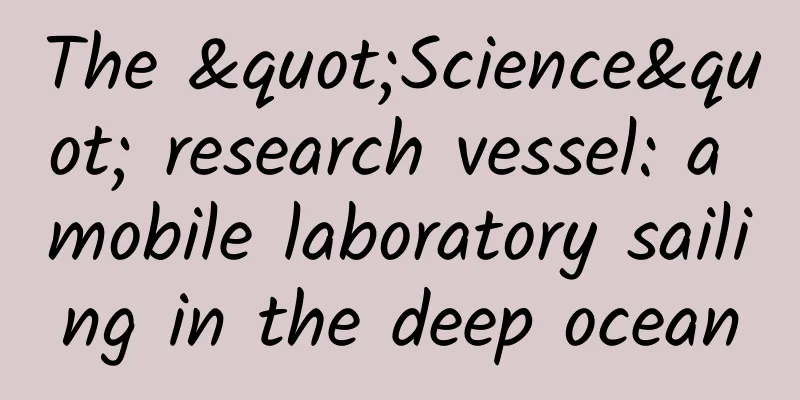The "Science" research vessel: a mobile laboratory sailing in the deep ocean

|
Produced by: Science Popularization China Author: Jiang Ruhan and Wang Min (Institute of Oceanology, Chinese Academy of Sciences) Producer: China Science Expo Going up to the sky, into the earth, and into the sea is the common dream of all mankind. The ocean is the largest area on the earth, but it is the area least known by humans. Our exploration and research area of the ocean only accounts for about 5% of the entire ocean, which is inferior to our understanding of space. Without modern marine equipment, the exploration and research of the ocean can only be "looking at the ocean and sighing". From Zheng He's voyages to the West, Columbus opening the Age of Discovery, to the British "Challenger" global ocean survey, the "Alvin" manned submersible conducting deep-sea exploration, to the "Struggler" manned submersible successfully landing on the bottom of the Mariana Trench, human beings have never stopped exploring the ocean. "Struggler" manned submersible (Photo source: China Shipbuilding Industry Corporation) "If you want to do your work well, you must first sharpen your tools." As an important platform for ocean exploration and research, scientific research vessels play an irreplaceable role in comprehensive ocean exploration and research. The 18th National Congress of the Communist Party of China made major strategic arrangements for building a strong maritime nation, opening a new era of marine science and technology development. The 19th National Congress of the Communist Party of China proposed to "adhere to the coordinated development of land and sea and accelerate the construction of a strong maritime nation." As a major national tool for marine scientific investigation, the "Science" research vessel has witnessed the glorious journey of the rapid development of my country's marine science and technology in the new era, and has written a new chapter in galloping across the magnificent deep sea and ocean. Video source: Institute of Oceanology, Chinese Academy of Sciences, Editing: Impressions of the Sea by China Science and Technology The "Science" sails through the waves (Photo credit: Institute of Oceanology, Chinese Academy of Sciences) 1. Carrying on the past and forging ahead in the future, the scientific research vessel "Changzi" of the new era Before the "Science" was put into service, there was no special design for my country's marine scientific research vessels. The bows were mostly upright or straight forward-leaning, and the hulls were relatively slender. Scientific research vessels such as the "Venus" and "Science No. 1" were mostly converted ships, and marine research activities were still at the stage of "using what is available". With the continuous improvement of my country's comprehensive national strength and the deployment and implementation of the strategy of building a strong maritime nation, higher requirements have been put forward for deep-sea scientific investigation capabilities. Focusing on deep-sea scientific investigation activities, the need to build a new generation of ocean-going comprehensive scientific research vessels has become increasingly urgent. In this era, the "Science" came into being and became the "pathfinder" of the new generation of scientific research vessels. The Science is ready to go after finishing touches (Photo credit: Institute of Oceanology, Chinese Academy of Sciences) During the design stage, the design team included captains and scientists of scientific research vessels with rich sea-going experience, who proposed scientific research needs. The China Ship and Ocean Engineering Design and Research Institute converted these needs into ship parameters for design, and finally came up with a "short and wide" ship type solution designed specifically for deep-sea scientific expeditions. Construction began by Wuchang Shipbuilding Heavy Industry Co., Ltd. in 2010, and it was officially put into use in 2012. The "Science" oceanographic research vessel is known as the "eldest son" of China's epoch-making comprehensive oceanographic research vessels, carrying the dreams of several generations of Chinese marine science and technology workers. After the "Science" was put into operation, its excellent performance was unanimously recognized by industry insiders. Subsequently, the "Science" sister ships [1] such as the "Xiangyanghong 01", "Xiangyanghong 03", and "Dongfanghong 3" were successively built and launched into service, making important contributions to the leapfrog improvement of my country's marine scientific research capabilities. 2. Excellent performance to build an offshore scientific laboratory The "Science" has a total length of 99.80 meters, a beam of 17.80 meters, a depth of 8.90 meters, a gross tonnage of 4711, a cruising range of 15,000 nautical miles, a capacity of 80 people, and has global navigation and all-weather observation capabilities to meet the needs of unlimited navigation areas. It is my country's most advanced scientific research vessel in terms of comprehensive performance. The "Science" uses a pod-type electric propulsion system, equipped with two bow thrusters, a 360-degree panoramic control platform, an unmanned cabin and a one-person bridge. The advanced pod-type electric propulsion system and two bow thrusters form the first DP-1 dynamic positioning system used in scientific research ships in China, which has excellent maneuverability and greatly improves the accuracy of scientific research activities. The pod-type electric propulsion system of the Science (Photo credit: Institute of Oceanology, Chinese Academy of Sciences) In view of underwater acoustic detection, the bulbous bow of the "Science" is optimized in the design, equipped with lifting fins and bow thruster slot cover, which can provide a low-noise acoustic detection environment. The "Science" has a rear deck of about 500 square meters, which can easily carry various scientific investigation equipment, providing more possibilities for deep-sea scientific investigations and a platform for multidisciplinary comprehensive investigation activities. The "Discovery" underwater cable-controlled robot carried on the "Science" (Photo source: Institute of Oceanology, Chinese Academy of Sciences) The front and rear decks can provide space for five containers, which has effectively promoted the modular development of scientific investigation equipment, shortened the time for ship preparation and equipment commissioning, and improved the efficiency of scientific investigation per unit time. The "Science" integrates seven major systems, including water body detection system, atmospheric detection system, seabed detection system, deep-sea extreme environment detection system, remote sensing information on-site verification system, shipboard experiments, and shipboard networks. It is equipped with a variety of internationally advanced detection equipment such as the 4,500-meter "Discovery" ROV. It has high-precision and long-term comprehensive ocean observation, detection, on-site sampling and analysis capabilities for dynamic environment, geological environment, ecological environment, etc., and is known as the "mobile laboratory at sea." Schematic diagram of the onboard detection and test system of the "Science" (Photo source: Institute of Oceanology, Chinese Academy of Sciences) 3. A strong team builds a high-quality deep-sea survey platform Unlike ordinary ships[2], the Science has three departments: the deck department, the engine department, and the onboard laboratory . The deck department is like the human brain. It is responsible for the formulation and execution of the ship's navigation instructions and cooperating in the completion of marine scientific investigation activities. It is composed of the captain, political commissar, first mate, second mate, third mate, duty sailors and the kitchen department. The engine room department is like a person's legs, cooperating with the ship's navigation instructions, providing power for the ship's navigation, and providing maintenance and technical support for the ship's mechanical and electrical equipment. It consists of the chief engineer, second engineer, third engineer, electronic and electrical personnel, and on-duty mechanics. The shipboard laboratory is like a person's hands. It relies on the advanced scientific investigation equipment carried by the "Science" to complete the scientific investigation mission of the voyage. It is composed of the chief scientist, the director of the shipboard laboratory, engineering and technical personnel, and seagoing team members. Silhouettes of various departments of the "Science" (Photo source: Institute of Oceanology, Chinese Academy of Sciences) The scientific research fleet of the Institute of Oceanology, Chinese Academy of Sciences was the first to put forward the slogan of "professional people doing professional work in marine investigation activities". Over the years, it has cultivated a scientific investigation team with close cooperation between the deck department, engine department and shipboard laboratory, with strong technical skills and tough work style. It has formed an efficient working mode in which engineering and technical personnel complete the operation of investigation equipment and basic sample collection work during the scientific investigation, and scientists at sea devote more energy to sample processing, providing solid technical support for marine scientific investigations and exploration research. A group photo of the Science crew (Photo source: Institute of Oceanology, Chinese Academy of Sciences) 4. Fruitful results of ten years of deep-sea survey Over the past ten years of operation, the "Science" research vessel has undertaken a number of major national scientific research projects, focusing on deep-sea exploration research, key core technologies and major scientific issues. It has carried out nearly 50 deep-sea survey voyages, crossed the equator ten times, accumulated more than 2,000 days of safe navigation, and sailed more than 300,000 nautical miles. It has provided more than 1,500 voyages for dozens of universities and research institutes across the country, providing an important marine technical support platform for conducting deep-sea research, safeguarding national marine rights and interests, and exploring deep-water resources, and has promoted my country's marine scientific investigation capabilities and research levels to the forefront of the world. The Discovery ROV conducts deep-sea scientific exploration (Photo credit: Institute of Oceanology, Chinese Academy of Sciences) Relying on the "Science" research vessel, the Institute of Oceanology of the Chinese Academy of Sciences took the lead in building a world-class comprehensive deep-sea exploration and research system, and made breakthroughs in key technologies such as 10,000-meter deep-sea fixed-point detection, 6,000-meter deep-sea detection and sampling, 4,500-meter deep-sea precision detection and sampling, 1,000-meter water body profile navigation detection, 30-meter deep-sea sediment coring and 20-meter long rock coring, achieving the goal of "being able to go down, see clearly, mine, measure accurately, have full functions and afford". For the first time in China, a detection technology system that combines "macro and micro, navigation and fixed-point, gradient and in-situ" has been established. It has the ability to conduct three-dimensional, synchronous and precise comprehensive detection and sample collection of deep-sea topography, seabed environment, and water environment. The resolution of deep-sea near-seabed topography detection has reached centimeter level, realizing the leap from "indoor simulation experiment → marine mobile laboratory → deep-sea in-situ laboratory"; it has successfully carried out deep-sea extreme environment detection, deep-sea field tests, seabed cultivation experiments and deep-sea in-situ long-term continuous detection, realizing the scientific idea of "moving the laboratory to the seabed", and leading my country's deep-sea detection and experimental capabilities into the ranks of the world's advanced countries. The "Science" conducts in-situ fixation experiments on deep-sea organisms (Image source: Institute of Oceanology, Chinese Academy of Sciences) Using the "Science" as a platform, we have focused on major scientific issues in the extreme deep-sea environments such as cold seeps, hydrothermal fluids, and seamounts in the western Pacific Ocean, and have achieved a series of original results and major breakthroughs. We have solved the world's difficult problem of real-time transmission of deep-sea buoy data, built the world's largest real-time scientific observation network in the western Pacific Ocean, and transformed deep-sea exploration from "video playback" to "live broadcast". The seafloor hydrothermal vents photographed by the Discovery (Photo credit: Institute of Oceanology, Chinese Academy of Sciences) The first in the world to carry out in-situ detection of temperature gradients of hydrothermal vent fluids, obtained temperature profiles of more than 30 hydrothermal vents (the highest temperature was 383.3℃), and discovered "combustible ice" exposed on the seabed for the first time in the South my country Sea. A total of more than 6,000 deep-sea large biological samples of more than 700 species were collected, and 1 new family, 1 new subfamily, 13 new genera, and 128 new species were discovered. More than 8,000 strains of deep-sea microorganisms (including 46 new bacterial species) were obtained, and the largest deep-sea large biological sample library with the largest number of samples and species and the only deep-sea large-scale chemotrophic biological living library in my country have been established. Deep-sea biological samples collected by the "Science" (Photo credit: Institute of Oceanology, Chinese Academy of Sciences) More than 3 tons of deep-sea geological samples were collected, and the country's first ultra-long sediment column sample (16.01 meters) with attitude and orientation information was obtained, pushing my country's deep-sea ocean research to the forefront of the world. The "Science" conducts deep-sea buoy deployment operations (Photo source: Institute of Oceanology, Chinese Academy of Sciences) In the international community, the "Science" cross-equator ocean expedition has also received great attention. Among them, "Nature" magazine has twice reported and commented on the "Science" and the improvement of my country's marine scientific investigation capabilities, praising it as "another feat 600 years after Zheng He's voyage to the West". With the help of the "Science", a major national weapon, researchers have crossed the equator and headed for the deep sea, continuously expanding their understanding of the Western Pacific Ocean and moving towards a wider sea area. Remark: [1] A sister ship is a ship of the same type or of nearly identical design as another ship. These ships have a nearly identical hull and superstructure layout, similar displacement, and roughly equivalent features and equipment. [2] Cargo ships are usually divided into the deck section and the engine room section. |
<<: A brief history of humankind: Are you happier than primitive people?
>>: A must-read for flu season! The latest flu vaccination guide for 2022 is here
Recommend
Drinking a bottle of Huoxiang Zhengqi water when you have a heat stroke? Nonsense, this is a suicidal act!
We all know how hot the weather has been recently...
7 cases of myocardial infarction were treated in one and a half days! Doctor: They all have these common characteristics!
Reviewer of this article: Chen Haixu, Deputy Dire...
The stench is so strong that even butterflies and bees are horrified. How domineering is the Rafflesia?
In the Pokemon game, there is a Pokemon that emit...
Android event distribution mechanism source code and example analysis
1. Understanding of the event distribution proces...
Yellow, black, red, transparent... What are these various colors of tape used for?
Speaking of tape, I believe everyone is familiar ...
Understanding the sharing, invitation and reward methods in APP fission and new user acquisition
Today's article will involve many details of ...
Can eating onions, fungus, and drinking vinegar "soften blood vessels"? These cognitive misunderstandings need to be understood
We often hear people say that eating certain food...
5 marketing promotion trends in 2022!
These are the worst of times. Short videos are be...
One trillion times brighter than the sun, this large scientific device will emit its first beam of light by the end of the year
The high-energy synchrotron radiation source of t...
LeEco FF91 finally unveiled, Apple engineer says CEO Jia is just trying to make money
Many people have their own "Dream Car" ...
The "blue chicken" unique to our country is mysterious and charming!
Recently, when sorting out infrared camera data i...
Mobile phone shipments surged by nearly 60%, the market is recovering, who is changing their phones?
Data released recently by the China Academy of In...
iOS 9 Human Interface Guidelines: UI Design Basics
1.1 Designing for iOS iOS embodies the following ...
The "sandwich dressing method" has become popular! When the temperature is "hovering" at freezing point, wear this way to keep warm →
In this cold season, how should we dress to keep ...









